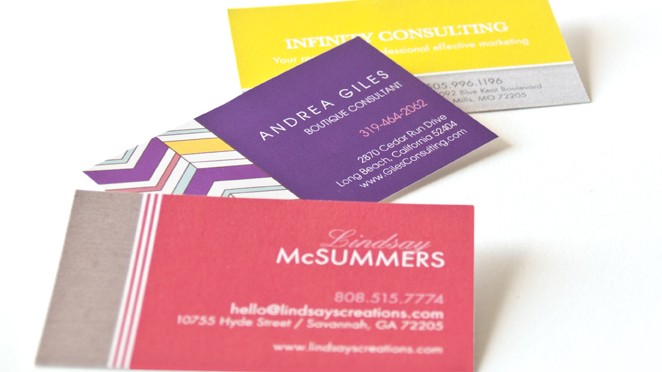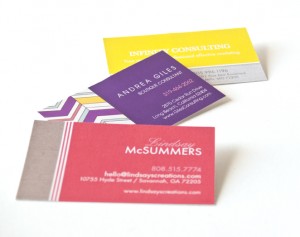It is never too soon to have a business card. Business cards’ usefulness spans more than just for professional use. Whether it be for networking purposes or just having a “Mommy Card,” a business card is a perfect way to exchange information. Despite its small size, a business card says a lot. And it is your job to make sure it says the right stuff!
- Your Name. Even if you’re giving out a business card for a large company, it is always nice for a person to know who their point of contact would be. Your name should be the most prominent piece of text in the business card.
- You Business/Organization’s Name. This should also be prominently featured on a business card, with the exception of if you have a highly recognizable logo.
- Address. If you anticipate sending or receiving mail from your business, including a physical address is key. If you are a freelancer, for example, including just your city or service area may be more appropriate.
- Phone Number. In a world where email is slowly becoming the number one way to communicate, including a phone number on a business card is easily forgotten. Calling someone is one of the more direct, quickest ways to get a hold of someone. Make sure to include your area code and be consistent with your use of parentheses, hyphens, periods or other characters.
- Email Address. As mentioned before, email is slowly becoming the number one method of correspondence. This item is particularly important for web-based businesses, but also for others as it is quite often the preferred means of contact.
- Web Page Address. Again, especially for web-based businesses. Also make sure that your site is live and running before you put it on a business card. Your web address can be listed with our without the http:// preceding the URL.
- Your Job Title. You don’t want your card to be a mystery card. Unless it is stated clearly on the card as to what you do, you’ll want to include a line of text that says either your position in a company, you talents, or a short description of what it is you offer.
- Tagline or Description of Business/Organization. This is particularly useful when the business’ name isn’t a clear indicator of what it is your business offers. A catchy tagline will also make your company more memorable.
- Logo. If you have one, a consistent use of your logo on all printed and web materials helps to establish a brand’s identity. (In many online design studios, it’s easy and free to upload your own image!)
- Graphic Images. Be careful with this one. You don’t want your business card to be too “cluttered.” This would be a good option to go with if you or your company didn’t have a logo. Whatever you use, make sure that it reinforces what your business does.
- List of Services or Products. This extends the usefulness of a business card – just make sure not to get too long winded. You want to leave someone with just enough to make them check out your website for more! This would be most appropriate on the backside of a two-sided business card.
Learn how to be your own designer with our March infographic which will give some tips and tricks on designing your perfect business card! What else have you included in your business cards? Let us know by leaving a comment below.




It’s actually a cool and helpful piece of information. I’m satisfied that you just shared this helpful info with us. Please keep us up to date like this. Thanks for sharing.
You’re very welcome!!